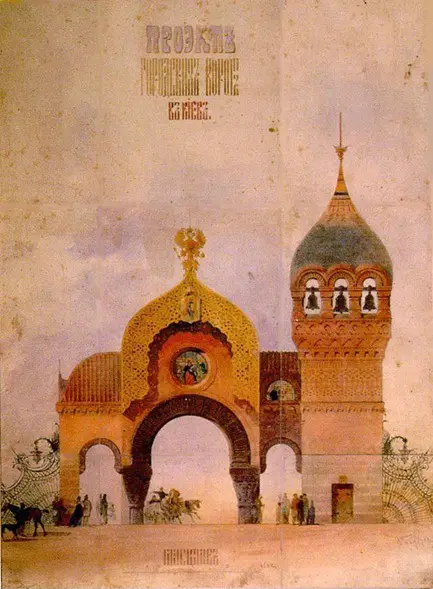The Great Gate of Kiev is the finale of Mussorgsky’s Pictures at an Exhibition. It is a classical piano suite based on 400 paintings by artist Victor Hartmann. The Golden Gate depicted by Hartmann, was built in 1037. Then Kyiv was at the height of its power and influence within the medieval world.
The city of Kyiv (Kiev) in Ukraine was a thriving trading centre, that straddled the silk routes from east to west. And the north-south route from the Black Sea to the Baltic. People from all parts of the world would have been to one of the most historical cities. Traders, artisans, philosophers and diplomats.
The Golden Gate of Kyiv
Nearly one thousand years ago the city of Kyiv was surrounded by a strong wall, protecting its great cathedral of St Sophia and its buildings of state. The home of Grand Prince Yaroslav the Wise, it sat at the top of a hill — a natural rampart. It was further strengthened by its imposing wall. Visitors could enter through one of three gates, the most magnificent of which was the Golden Gate. The other gates, the Polish and the Jewish Gates, were merely tradesmen’s entrances.
This beautiful, culturally and politically influential city became a target for attacks by a series of invaders, starting with rival prince Andrey Bogulyubsky in 1169. Bogulyubsky destroyed the old town of Kyiv and the court. Then moved the capital of Kievan Rus’ to the city of Vladimir.
Further invasions by Rus princes followed until the more decisive Mongol invasion took place in 1240. The city was destroyed, the Golden Gate and the great cathedral of St Sofia razed to the ground.
At last, in the twenty-first century, in finally independent Ukraine, the Golden Gate was reconstructed… It was a wonderful achievement after so many centuries. A tourist attraction with an interpretive museum inside.
Abstract from History of Yesterday – Alison Marshall

Mussorgsky – ‘Great Gate of Kiev’
Exalted by a suite of fifteen classical pieces by Russian composer, Petrovich Mussorgsky, the Great Gate of Kiev, is not actually a gate but a design submitted by artist Victor Hartmann to commemorate the attempted assassination of Tsar Alexander II in the city of Kiev in 1866.
Hartmann’s majestic design for The Great Gate of Kiev caused a sensation, and the artist believed it was the finest work he had ever done. The sketch for stone gates to replace the wooden gates of Kiev incorporated a cupola in the form of a Slavonic helmet. In the design, the archway rested on granite pillars and its peak was to be decorated with a huge headpiece of Russian carved designs including the Russian state eagle.
To commemorate what was referred to by the Tsar as “the event of April 4, 1866”, a design competition commenced. Though proposals poured in including a drawing by Hartmann, Russian authorities scrapped the effort and while the Tsar may have been relieved to dodge assassination, explicit acknowledgement of the event may have led to the cancellation of the competition.
Hartmann’s early death at the age of thirty-nine devastated Mussorgsky, a close personal friend. Distraught by his friend’s passing, Mussorgsky agreed to become involved in a commemorative art exhibition of over 400 paintings by his friend. The exhibition inspired Mussorgsky to complete a classical piano suite, Pictures at an Exhibition, representing pieces of Hartmann’s artwork.
Sadly, Mussorgsk’s homage to his friend was universally ignored until Ravel arranged the work to be played by a symphonic orchestra. While Pictures in an Exhibition has since been orchestrated by at least ten different composers, Ravel’s work is easily the most popular finishing with a bombastic, enthusiastic interpretation of The Great Gate of Kiev, fully reflecting Hartmann’s celebratory design.
Ukraine.com
The Great Gates of Kiev – Emerson, Lake and Palmer
From the album Pictures at an Exhibition – The Great Gates of Kiev is treated to a manic performance of total chaos by Keith Emerson in ELP’s 1974 concert.
In the midst of Emerson’s crazed, demonic artistry, one can imagine the panic, destruction and carnage of the Mongol invasion in 1240. The city was destroyed, and the Golden Gate was razed to the ground. And to top it all he plays a revolving grand piano as the world spirals to an end.
Greg Lake gives a masterful rendition of the lyrics, and Carl Palmer is… Carl Palmer.
The Great Gates of Kiev – Lyrics
Come forth, from love’s pyre
Born in life’s fire
Born in life’s fire
Come forth, from love’s fire
In the burning, all are yearning
For life to be
And in pain there will be gain
Blasts of new life!
Stirring in, salty streams
And dark hidden seams
Where the fossil sun gleams
They were, sent from the gates
Ride the tides of fate
Ride the tides of fate
They were, sent from the gates
In the burning all are yearning
For life to be
They were, sent from the gates
Ride the tides of fate
Ride the tides of fate
They were, sent from the gates
In the burning all are yearning
For life to be
Oh, to be
To be!
There’s no end to my life
No beginning to my death
Death is life.
Songwriters: Hubert Ralph / Modest P. Mussorgsky
The Great Gates of Kiev lyrics © Warner/Chappell Music, Inc
Why not Join Us
If you enjoyed this article, we would like to offer you two gifts – our Starter Pack of 4 James King’s books and our Weekly Digest, which you can receive by email.

